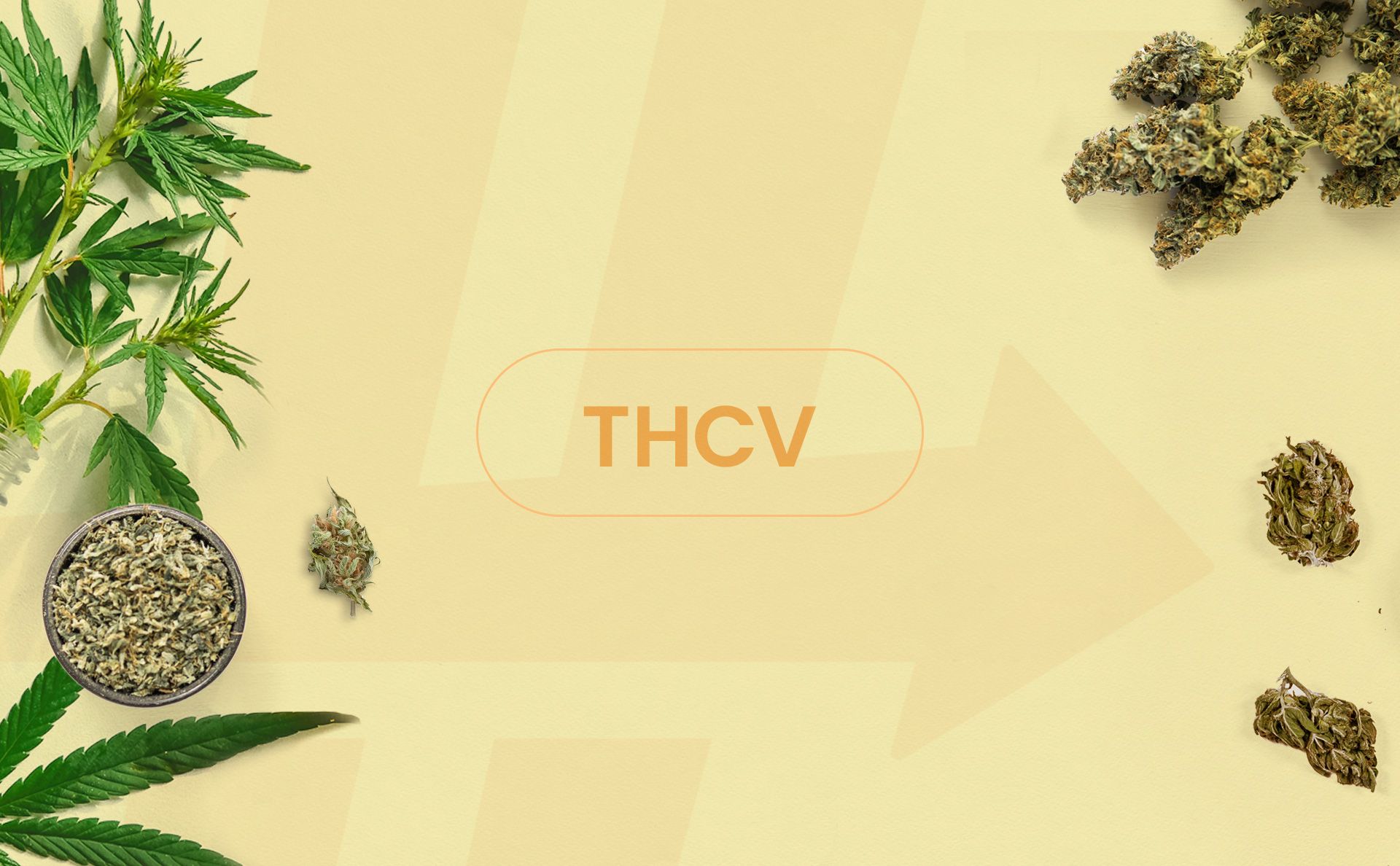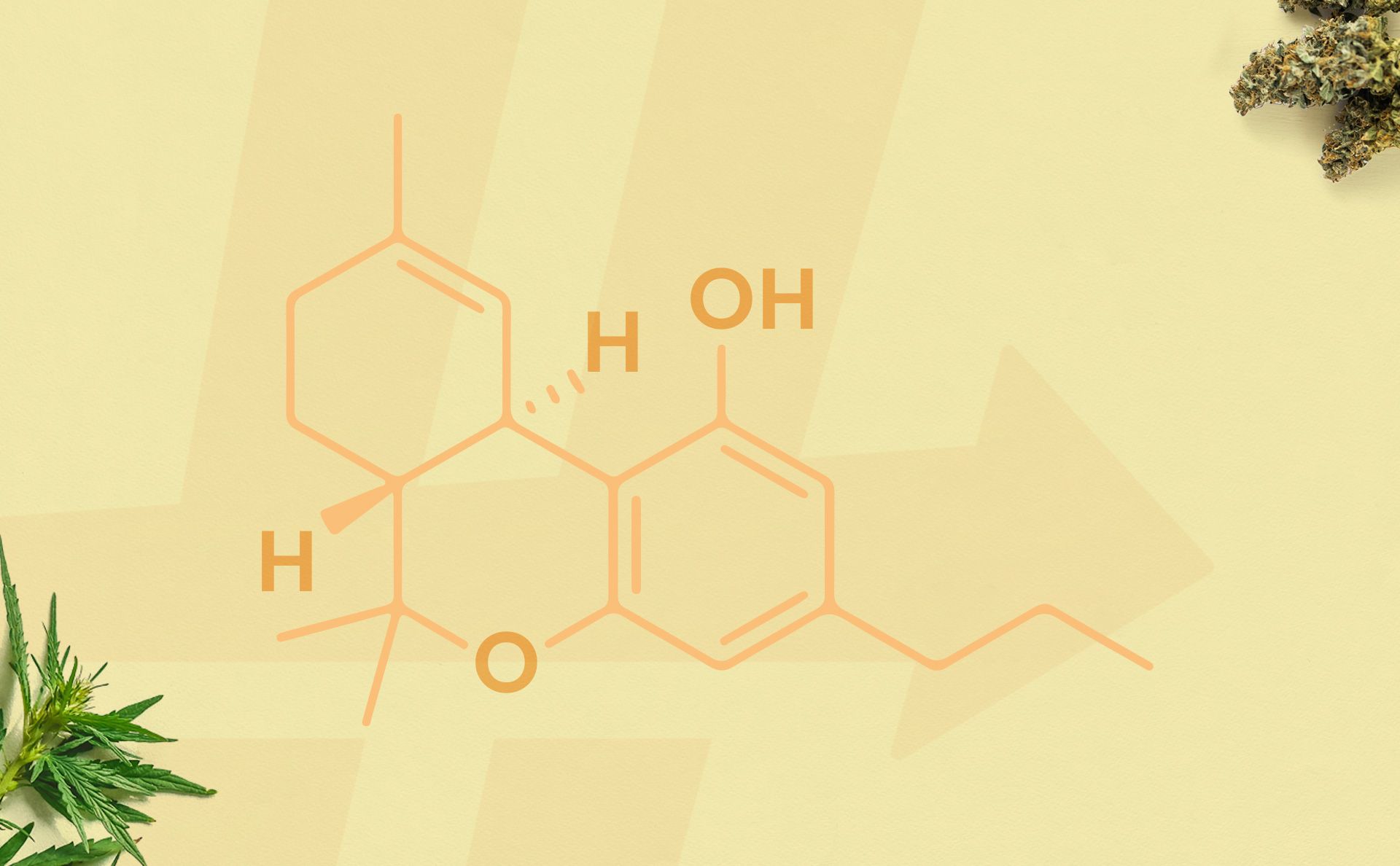THCV
THCV is a special cannabinoid distinct from THC and the hundreds of other compounds found in cannabis. What is THCV, what are its effects, and what are its benefits? This chapter answers these questions and more.

What is THCV?
You may not have heard of it before, but THCV is actually the third-most studied cannabinoid out there. THCV, or tetrahydrocannabivarin, is nearly identical in molecular structure to its sibling cannabinoid, THC, except that it’s just 2 carbons shorter.
Like other cannabinoids It’s made from acidic precursors like cannabigerovarin acid (CBGVA), the varinic counterpart of CBGA, which gives rise to THCVA, and is then “decarbed” into THCV with heat or light.
THCV’s 3-carbon tail instead of a 5-carbon tail gives it the “-varin” title, and negates the intoxicating properties seen with THC. That’s because its tail is just long enough to bind CB1, but too short to trigger it in the same way.

Instead, THCV offers a mix of familiar and unique potential therapeutic benefits in ways we are continuing to understand. It shares several key properties with THC – while directly opposing some – all without the high. Some tout it as a weight loss or diabetes remedy, but with only small clinical studies behind it.
Effects of THCV
Counterintuitively, you can simply think of THCV as largely being the inverse of THC – doing the opposite of what you’d expect.
THCV can bind to CB1 with about half the affinity of regular THC. But it interacts with it in different ways. If THCV sees THC dancing closely with CB1, it will try to step in to break things up like a chaperone at a school dance. This behavior is called competitive antagonism.
If isolated, THCV produces very different effects than delta-9 THC. When alone, it behaves as an inverse agonist. Meaning that when it binds to CB1, it produces the exact opposite effects you normally expect from CB1. This means reduced highs, less appetite, and greater tolerability for a wider range of patients.
Beyond CB receptors, it also works on important receptors like TRP channels (i.e., TRPV1-4, TRPA1) for relieving pain, and serotonin receptors (e.g., 5HT1A) for improving mood and nausea.

What the expert says...
Dr. Abraham Benavides
"THCV acts like the opposite of THC. It is often touted as an appetite suppressant, antidiabetic, and weight-loss drug. There is some clinical research behind this, but there are many other potential therapeutic properties to also understand and unlock."
Potential Benefits of THCV
There is some preliminary and clinical evidence that THCV has potential benefits. For instance, THCV may reduce appetite, the opposite of what THC does. We understand this because THCV inversely activates the CB1 receptor in the brain.
One of the early preclinical studies shows that when administered isolated THCV, THCV increased insulin sensitivity in obese mice. Some studies show mice ate less and lost weight, but some did not. Importantly, THCV did improve lipid and glucose metabolism in these mice.
Clinical research is more promising. A 2016 study found that THCV may reduce fasting glucose and glucose intolerance, suppress appetite, promote weight loss, and improve pancreatic B-cell function in type 2 diabetic patients.
Clinical studies have shown THCV is well-tolerated, safe, and doesn't have the same psychiatric risk that other CB1 blockers like rimonabant does. Rimonabant was a previously legal prescription CB1 blocker that was pulled off the market due to causing suicidal ideation.
It’s important to know that THCV is a safe and well-tolerated CB1 inverse agonist and selective antagonist we could use someday to treat type 2 diabetes, obesity, chronic liver diseases, and more. THCV shows many potentially therapeutic properties worthy of further investigation, like:
- Neuroprotective
- Anti-inflammatory
- Anti-epileptic
- Antipsychotic
- Pain-relieving
- Anticancer
- Reduce nausea and vomiting (shown in mice)
- Antiacne
- Promote bone health
- Counteracting muscular dystrophies
In clinical studies, THCV is well-tolerated in doses of 5mg twice daily. Beyond that, we don't know much about its potential side effects, but they are likely dose-dependent and may include:
- Decreased appetite
- Weight loss
- Diarrhea
- Dizziness
- Dysphoria (anecdotally in high doses)
Does THCV Get You High?
No, there are also no known intoxicating effects of THCV, so it’s safe to ingest for adults, but does not get you high. In fact, it can reduce the high, memory impairment, and some of the uncomfortable mental and physical effects of THC.
The most common change in normal behavior is that people may feel a little more tired than normal after consuming THCV. We don't know yet how it affects special populations like kids and pregnant people.
Because THCV is a minor cannabinoid and an isolated compound, acquiring the cannabinoid is difficult. A limited number of cannabis plants actually produce amounts of THCV that are abundant enough to study with any relevance. However, new selective breeding techniques are giving rise to THCV-rich cultivars.
THCV can also famously be found in South African cannabis chemotypes, or “landrace strains”. One of the most popular cultivars on the market today that contains THCV in abundance is Dayslayer.
Be advised, there may be some industry actors who create semisynthetic THCV products. While the THCV inside may appear identical, the process to create it this way is messy and may leave behind unknown byproducts and residues that can cause short and long-term health effects we don't know about yet. Choose organic and certified THCV hemp products that are independently lab tested for safety and purity.
What We Learned: THCV
As is the case with all minor cannabinoids, products containing enough THCV for proper testing are lacking, which is the main cause of it being understudied. Here’s what we learned about THCV:
- THCV, or tetrahydrocannabivarin, is only 2 carbons shorter than THC, but has a mix of some shared and unique effects
- THCV, if isolated, can produce opposite effects from Delta-9 THC.
- THCV is non-impairing, so it does not get you high.
- This cannabinoid may play a role in mitigating the high, memory impairment, munchies, potential negative effects, and physical feelings of delta-9 THC.
- THCV is emerging in clinical research as a popular appetite suppressant and weight-loss drug,
- THCV shares neuroprotective, anti-inflammatory, pain-relieving, and antiepileptic effects with THC without the cognitive effects.
As we continue to remove the layers of cannabis prohibition, we will see increased yield and supply chain accessibility to quality cannabis. This may inspire cannabis producers to increase products and cultivars that contain THCV, which may then be studied.
You did it! You completed the Cannabinoids Guide on THCV! Excellent work. What’s next?
Citations
- Abioye, A., Ayodele, O., Marinkovic, A., Patidar, R., Akinwekomi, A., & Sanyaolu, A. (2020). Δ9-Tetrahydrocannabivarin (THCV): A commentary on potential therapeutic benefit for the management of obesity and diabetes. Journal of Cannabis Research, 2(1), 6.https://doi.org/10.1186/s42238-020-0016-7
- Barré, T., Di Marzo, V., Marcellin, F., Burra, P., & Carrieri, P. (2023). Expanding Research on Cannabis-Based Medicines for Liver Steatosis: A Low-Risk High-Reward Way Out of the Present Deadlock? Cannabis and Cannabinoid Research, 8(1), 5–11.https://doi.org/10.1089/can.2022.0014
- Cascio, M. G., Zamberletti, E., Marini, P., Parolaro, D., & Pertwee, R. G. (2015). The phytocannabinoid, Δ9-tetrahydrocannabivarin, can act through 5-HT1A receptors to produce antipsychotic effects. British Journal of Pharmacology, 172(5), 1305–1318.https://doi.org/10.1111/bph.13000
- Citti, C., Linciano, P., Russo, F., Luongo, L., Iannotta, M., Maione, S., Laganà, A., Capriotti, A. L., Forni, F., Vandelli, M. A., Gigli, G., & Cannazza, G. (2019). A novel phytocannabinoid isolated from Cannabis sativa L. with an in vivo cannabimimetic https://doi.org/10.1038/s41598-019-56785-1
- Englund, A., Atakan, Z., Kralj, A., Tunstall, N., Murray, R., & Morrison, P. (2016). The effect of five day dosing with THCV on THC-induced cognitive, psychological and physiological effects in healthy male human volunteers: A placebo-controlled, double-bhttps://doi.org/10.1177/0269881115615104
- Farrelly, A. M., Vlachou, S., & Grintzalis, K. (2021). Efficacy of Phytocannabinoids in Epilepsy Treatment: Novel Approaches and Recent Advances. International Journal of Environmental Research and Public Health, 18(8), 3993.https://doi.org/10.3390/ijerph18083993
- Iannotti, F. A., Pagano, E., Moriello, A. S., Alvino, F. G., Sorrentino, N. C., D’Orsi, L., Gazzerro, E., Capasso, R., De Leonibus, E., De Petrocellis, L., & Di Marzo, V. (2019). Effects of non‐euphoric plant cannabinoids on muscle quality and performancehttps://doi.org/10.1111/bph.14460
- Idris, A. I., & Ralston, S. H. (2012). Role of cannabinoids in the regulation of bone remodeling. Frontiers in Endocrinology, 3, 136. https://doi.org/10.3389/fendo.2012.00136
- Jadoon, K. A., Ratcliffe, S. H., Barrett, D. A., Thomas, E. L., Stott, C., Bell, J. D., O’Sullivan, S. E., & Tan, G. D. (2016). Efficacy and Safety of Cannabidiol and Tetrahydrocannabivarin on Glycemic and Lipid Parameters in Patients With Type 2 Diabeteshttps://doi.org/10.2337/dc16-0650
- Mboumba Bouassa, R.-S., Sebastiani, G., Di Marzo, V., Jenabian, M.-A., & Costiniuk, C. T. (2022). Cannabinoids and Chronic Liver Diseases. International Journal of Molecular Sciences, 23(16), Article 16.https://doi.org/10.3390/ijms23169423
- Nallathambi, R., Mazuz, M., Ion, A., Selvaraj, G., Weininger, S., Fridlender, M., Nasser, A., Sagee, O., Kumari, P., Nemichenizer, D., Mendelovitz, M., Firstein, N., Hanin, O., Konikoff, F., Kapulnik, Y., Naftali, T., & Koltai, H. (2017). Anti-Inflammatorhttps://doi.org/10.1089/can.2017.0027
- Pinto, J. V., Saraf, G., Frysch, C., Vigo, D., Keramatian, K., Chakrabarty, T., Lam, R. W., Kauer-Sant’Anna, M., & Yatham, L. N. (2020). Cannabidiol as a Treatment for Mood Disorders: A Systematic Review: Le cannabidiol comme traitement des troubles de l’https://doi.org/10.1177/0706743719895195
- Rock, E. M., Sticht, M. A., Duncan, M., Stott, C., & Parker, L. A. (2013). Evaluation of the potential of the phytocannabinoids, cannabidivarin (CBDV) and Δ9-tetrahydrocannabivarin (THCV), to produce CB1 receptor inverse agonism symptoms of nausea in ratshttps://doi.org/10.1111/bph.12322
- Russo, E. B. (2011). Taming THC: Potential cannabis synergy and phytocannabinoid-terpenoid entourage effects. British Journal of Pharmacology, 163(7), 1344–1364.https://doi.org/10.1111/j.1476-5381.2011.01238.x
- Salami, S. A., Martinelli, F., Giovino, A., Bachari, A., Arad, N., & Mantri, N. (2020). It Is Our Turn to Get Cannabis High: Put Cannabinoids in Food and Health Baskets. Molecules, 25(18), 4036.https://doi.org/10.3390/molecules25184036
- Shahbazi, F., Grandi, V., Banerjee, A., & Trant, J. F. (2020). Cannabinoids and Cannabinoid Receptors: The Story so Far. iScience, 23(7).https://doi.org/10.1016/j.isci.2020.101301
- Tetrahydrocannabivarin. (n.d.). Retrieved August 29, 2023, fromhttps://go.drugbank.com/drugs/DB11755
- Walsh, K. B., McKinney, A. E., & Holmes, A. E. (2021). Minor Cannabinoids: Biosynthesis, Molecular Pharmacology and Potential Therapeutic Uses. Frontiers in Pharmacology, 12, 777804.https://doi.org/10.3389/fphar.2021.777804
Test your knowledge, track your progress and earn your badge.
Does THCV get you high?

Dr. Abraham Benavides
Dr. Abraham Benavides is an internationally-recognized cannabis research expert, experienced medical advisor, and full-tuition merit scholar of the George Washington University School of Medicine and Health Sciences. Dr. Abe enjoys helping patients as a writer, educator, and cannabis health coach at the GW Center for Integrative Medicine.